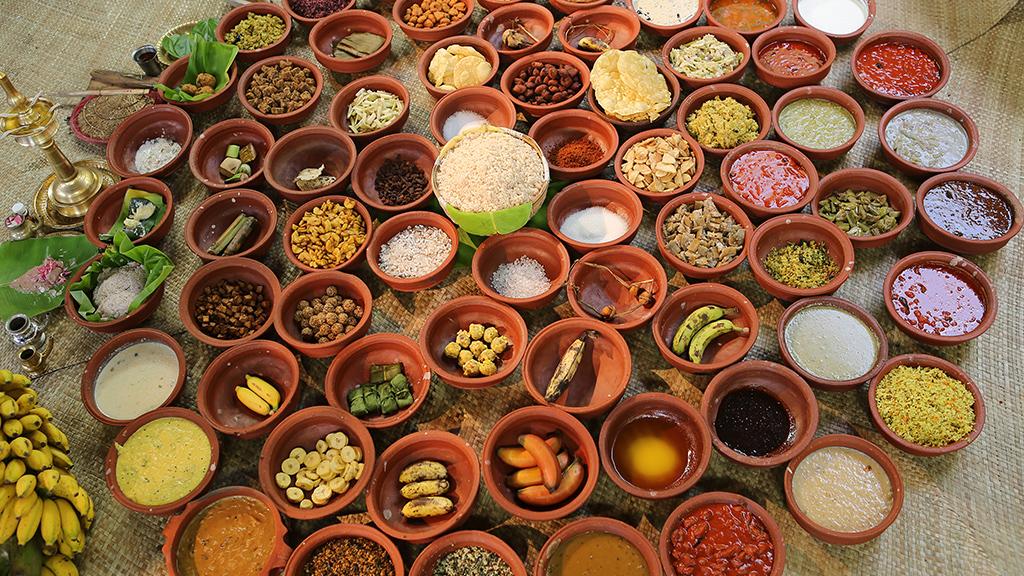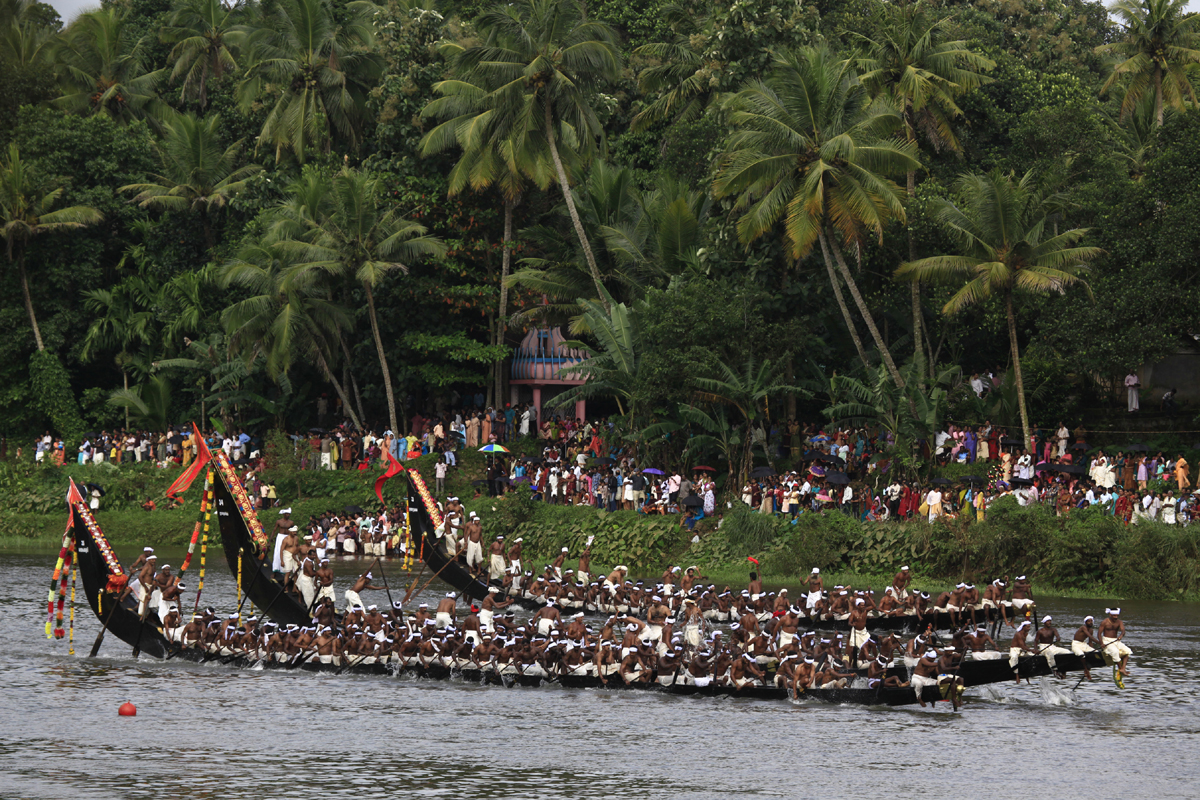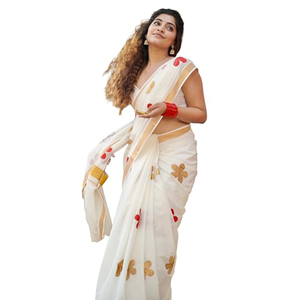The Aranmula Valla Sadya: A Sacred Feast Woven into Kerala Folklore

Image by RajeshUnuppally at Malayalam Wikipedia, CC BY 3.0
In the verdant heart of Kerala, where ancient traditions flow as freely as the Pamba River, lies Aranmula – a village steeped in spiritual grandeur and cultural vibrancy. Central to its identity is the Aranmula Vallasadya, an extraordinary ritualistic feast that transcends a mere meal, embodying a profound blend of devotion, community, and heritage. This grand vegetarian feast, deeply intertwined with the famed Aranmula Vallamkali (snake boat race) and the revered Sree Parthasarathy Temple, stands as a living testament to centuries of faith and fellowship. It is not merely a culinary event but a sacred offering, a vibrant celebration of Kerala's soul that draws thousands annually to partake in its unique spectacle and spiritual essence.
The Aranmula Vallasadya is steeped in a rich historical narrative, woven with threads of divine intervention and communal bravery that have shaped its enduring legacy. The Vallasadya of the year 2025 will be held from July 13 to October 2. The Devaswom Board has arranged a booking facility for devotees to participate in the Sunday Vallasadya. Bookings can be made directly at the temple counter or by calling the phone number +91 91889 11536.
Origins and the Thiruvona Thoni
The genesis of the Aranmula Vallasadya and its associated boat race is rooted in a captivating legend. It is said that a devout Brahmin, the Bhattathiri of Kattoor Mangadu Illam, vowed to provide all the essential provisions for the Thiruvona Sadya (a special feast for the Thiruvonam asterism) at the Aranmula Sree Parthasarathy Temple. These provisions were to be transported by a special boat known as the Thiruvona Thoni. During one such journey, the Thiruvona Thoni faced an attack by bandits. Local people, upon learning of the assault, swiftly came to the Brahmin's aid, arriving in their own boats to protect the sacred vessel and its precious cargo. This act of unity and valor is believed to have given rise to the tradition of the Aranmula Boat Race and the accompanying feast, commemorating the rescue and the protective spirit of the community. The water procession seen today is a direct remembrance of this pivotal event.
The Divine Connection: Lord Krishna and Arjuna
The Aranmula Parthasarathy Temple, the spiritual epicenter of these festivities, is dedicated to Lord Krishna, also known as Parthasarathy, a name emphasizing his role as Arjuna's charioteer. It is one of the 108 Divya Desams, revered Vishnu temples praised by the Alvar saints. Local folklore suggests that the Pandava prince Arjuna himself installed the idol of Lord Parthasarathy in Aranmula as a token of gratitude for divine assistance during the Kurukshetra war. Another legend attributes the village's name, Aranmula ("six bamboos"), to Lord Krishna's appearance on the Pamba River on a raft made of six bamboos. The Palliyodams, the unique snake boats, are considered sacred and are believed to embody the spirit of Lord Krishna, with divine presence and blessings thought to be upon them during the race. The entire event, including the feast, is seen as an offering to Lord Krishna.
Evolution and Longevity
The tradition of Aranmula Vallasadya is ancient, with some accounts suggesting it is around 700 to 1,800 years old. What makes it truly exceptional is its duration; it is recognized as one of the longest mass ritual feasts in the world, often spanning over 60 to 72 days, typically from July to October, coinciding with the Onam festivities. This extended period allows thousands of devotees and visitors to partake in the grand culinary and spiritual experience annually.
The Sacred Vessels: Palliyodams
Integral to the Aranmula Vallasadya are the majestic Palliyodams, the traditional snake boats that are far more than mere vessels; they are sacred entities.
Description and Significance
Palliyodams are the unique snake boats of Aranmula, distinct from other snake boats in Kerala due to their relatively larger and taller structure. These intricately crafted boats are revered as sacred vessels and are considered an integral part of Aranmula's cultural and religious heritage. Each Palliyodam is associated with specific regions or Karas (villages) around Aranmula, fostering a deep sense of local identity and pride. They are dedicated to the deity at the Aranmula Parthasarathy Temple and are believed to embody the spirit of Lord Krishna himself.
Symbolism in Design
The design of the Palliyodams is rich with spiritual symbolism. Traditionally built from Anjili wood, these boats feature a long, narrow shape with a raised prow that strikingly resembles a snake. This form is specifically designed to represent Ananthan, the sacred serpent in Hindu mythology, and Lord Mahavishnu's Ananthashayanam, the posture in which Lord Vishnu reclines on Ananthan. Furthermore, the boats incorporate numerical symbolism: there are nine golden figures attached to the stern, representing the Navagraha (nine planets). The sixty-four oarsmen who propel the boat symbolize the sixty-four traditional art forms of Kerala, while the four helmsmen at the rear, responsible for steering, represent the four Vedas: Rigveda, Samaveda, Atharvaveda, and Yajurveda. This intricate design underscores the profound spiritual and cultural significance embedded within every aspect of the Palliyodam.
Rituals and Community Involvement

Image courtesy: Department of Tourism, Kerala
Before participating in the Vallamkali or arriving for the Sadya, the Palliyodams undergo purification rituals and receive blessings at the Aranmula temple. The construction, maintenance, and rowing of these sacred boats involve the entire community, symbolizing unity and collective effort. There are strict traditional rules governing the Palliyodams: only men who observe specific preparations and vows (vritham) are permitted to touch and row them. The places where these boats are housed, known as Palliyodappura, are considered sacred, and outsiders are generally not allowed inside, further emphasizing their revered status. The annual Vallasadya feast itself is offered to the rowers as a mark of profound respect and gratitude for their role in upholding this sacred tradition.
The Melodies of Devotion: Vanchippattu
The air around Aranmula during the Vallasadya is perpetually charged with the rhythmic chants of Vanchippattu, the traditional boat songs that are the soul of the celebration.
Role in Vallasadya and Boat Race
Vanchippattu is an integral part of both the Aranmula Boat Race and the Vallasadya. These rhythmic folk songs are sung by the oarsmen of the Palliyodams to maintain perfect rhythm and coordination during rowing, transforming the physical act into a synchronized, almost meditative performance. As the Palliyodams arrive at the temple ghats for the feast, the oarsmen circumambulate the temple, their voices echoing through the premises with Vanchippattu, creating a mystical and joyous atmosphere that heralds their arrival. The songs continue during the feast itself, adding a unique, interactive dimension to the dining experience.
Themes and Significance
The lyrics of Vanchippattu predominantly revolve around themes of devotion, heroism, and local folklore. Many songs are praises to Lord Krishna, particularly his form as Parthasarathy, the presiding deity of the Aranmula temple. During the Vallasadya, the Vanchippattu takes on a playful yet deeply spiritual character: the oarsmen, through the verses of their songs, theatrically request specific dishes from the elaborate spread. A unique and sacred protocol dictates that every dish requested in this manner must be served without refusal. This tradition stems from the profound belief that it is Lord Krishna himself, disguised among the oarsmen, who is making these requests, transforming the act of serving into a direct offering to the divine. This interactive element makes the feast a unique blend of celebration and spiritual offering, fostering a dynamic and energetic ambiance.
Notable Vanchippattu
Aranmula boasts its own specific Vanchippattu compositions, enriching its unique cultural fabric. Notable among these are songs like Kuchelavritham, Bheeshmaparvam, and Santhanagopalam. Ramapurath Warrier is revered as the "Father of Vanchippattu," and his work, particularly Kuchela Vritham Vanchippattu, is highly celebrated. This particular composition, depicting the story of Lord Krishna's childhood friend Kuchelan and his struggles with poverty, is said to have been Warrier's subtle way of conveying his own difficulties to the Travancore King, who reportedly deciphered the hidden message and rewarded him. The songs are broadly categorized into Vanchippattu and Vachupatt, sung in different meters (vrithams) like Nadonnatha vritham and Kaakali vritham, each contributing to the rich sonic tapestry of the event.
The Grand Feast: Vallasadya Dishes
The Vallasadya is a culinary marvel, renowned for its sheer scale and the incredible variety of traditional Kerala vegetarian dishes.
Scale and Scope
Recognized as one of the largest vegetarian feasts in the world, the Aranmula Vallasadya attracts an estimated 2 lakh people annually to the Aranmula Parthasarathy Temple. This extraordinary feast typically features an impressive spread of over 60 to 70 dishes, though some accounts mention up to 101 varieties, particularly on special days like Ashtami Rohini, Lord Krishna's birthday. To maintain spiritual purity, all dishes are meticulously prepared without the use of onion or garlic. The sheer volume and diversity of the menu make it a truly unique culinary experience.
Serving Protocol
The grand feast is served in traditional dining halls known as Oottupura, which are historically part of temple structures used for communal dining. The dishes are laid out on fresh plantain leaves, and there is a specific style and defined form in which they are served and eaten. The dishes are categorized into three main varieties and presented according to tradition.
A truly unique aspect of the Vallasadya is the interactive serving process. As the feast progresses, the oarsmen, through the verses of their Vanchippattu, playfully yet devotionally request more rice and specific dishes by name. This sing-song demand is a key ritual, and a strict protocol dictates that every dish they ask for must be served without refusal. This custom is rooted in the belief that by fulfilling these requests, devotees are not merely serving the boatmen but are, in fact, serving Lord Krishna himself, who is believed to be present among them. This dynamic interaction creates an atmosphere filled with fun, energy, and a profound sense of spiritual offering.
Taboos and Restrictions
While the Vallasadya is a celebration of abundance, certain traditional protocols and restrictions are observed. Foremost among these is the strict avoidance of onion and garlic in the preparation of any of the dishes, ensuring the spiritual purity of the feast. The most significant taboo is the absolute prohibition against refusing any dish requested by the oarsmen through their Vanchippattu. This non-refusal policy is central to the spiritual essence of the Sadya, reinforcing the belief that the requests come from the divine.
In modern times, entry to the Vallasadya is often restricted through special passes, and it is explicitly stated that booking through third-party tour packages is not allowed, emphasizing the ritualistic and community-focused nature of the event over commercialization. Furthermore, the Vallasadya is traditionally not held on the day of the Uthrattathi Vallamkali or on the main Onam day.
Cultural Significance and Community Spirit
Symbol of Unity and Devotion
The Vallasadya profoundly fosters a sense of community and devotion. It is a celebration where traditional societal distinctions like caste, creed, and social status are set aside, replaced by the shared joy of faith and festivity. People from diverse backgrounds, both within Kerala and from across the globe, gather to witness and partake in this sacred offering, embodying a spirit of togetherness that defines the essence of Kerala's traditional lifestyle.
The collective effort involved in its preparation and execution, from the building of the Palliyodams to the serving of the feast, underscores a powerful sense of unity and collective identity. The belief that Lord Krishna himself participates among the devotees further strengthens this communal bond, elevating the entire event to a divine communion.
Preservation of Heritage
This centuries-old tradition serves as a vital custodian of Kerala's rich cultural heritage. The Vallasadya, along with the Vallamkali, showcases traditional Kerala architecture, intricate wood carvings, ancient murals, and the unique art form of Vanchippattu, preserving practices that might otherwise fade. It is a living, breathing form of devotion, a continuous thread connecting the present generation to the myths, legends, and customs of their ancestors. As a significant part of the larger Onam celebrations, it reinforces the cultural calendar and the values associated with the harvest festival.
Tourism and Economic Impact
Beyond its spiritual and cultural dimensions, the Aranmula Vallasadya is a major cultural spectacle and a significant tourist attraction, drawing thousands of visitors, both domestic and international, to the shores of Aranmula annually. The event provides a unique opportunity for cultural enthusiasts and travelers to experience a rare combination of ritual and spectacle.
The KSRTC Tourism Cell, recognizing its appeal, organizes special trips as part of its Pancha Pandava Temple Circuit, further boosting tourism to the region. This influx of visitors contributes to the local economy, supporting livelihoods and showcasing the unique charm of Aranmula, with its heritage homes and serene riverbanks.
The Aranmula Vallasadya stands as a magnificent embodiment of Kerala's profound cultural depth and spiritual devotion. More than just the world's longest mass vegetarian feast, it is a vibrant, living ritual that seamlessly weaves together ancient legends, sacred customs, rhythmic boat songs, and an unparalleled culinary experience. From the legendary rescue of the Thiruvona Thoni to the symbolic design of the Palliyodams and the interactive Vanchippattu requests during the meal, every aspect of the Vallasadya resonates with stories of divine connection and communal harmony.
It is a powerful testament to unity, faith, and the enduring legacy of a community that continues to honor its heritage with unwavering spirit. The Vallasadya is truly an expression of Kerala's soul, offering a unique and unforgettable glimpse into the heart of its folklore and traditions.
Bring Tradition Home
(Amazon Affilate Ad)
Inspired by the cultural richness of Aranmula Valla Sadya? Add a touch of heritage to your daily life with this best-selling copper water bottle. Combining traditional design with modern wellness, it's perfect for those who value both style and health.
Buy on AmazonReferences
Books
- Richard M.Dorson. edi: Folklore and Folklife, The University of Chicago Press1972
- Alan Dundes, The Study of Folklore, Prentice,Hall., EnglewoodCliffs, N.J,1965
- പി.കെ ഗോപാലകൃഷ്ണൻ ,കേരളത്തിന്റെ സാംസ്കാരിക ചരിത്രം, കേരള ഭാഷാ ഇൻസ്റ്റിറ്റ്യൂട്ട്, 2000
- ഡോ.എം.വി.വിഷ്ണു നമ്പൂതിരി, നാടോടി വിജ്ഞാനീയം, ഡി.സി.ബുക്സ്, 2007
- ഡോ.രാഘവൻ പയ്യനാട്, ഫോക് ലോർ, കേരള ഭാഷാ ഇൻസ്റ്റിറ്റ്യൂട്ട് 1997
- ഡോ.എം.വി.വിഷ്ണു നമ്പൂതിരി, ഫോക് ലോർ നിഘണ്ഡു, കേരള ഭാഷാ ഇൻസ്റ്റിറ്റ്യൂട്ട്, 2000
Websites
- https://www.keralatourism.org/event/aranmula-valla-sadya/124/
- https://prd.kerala.gov.in/ml/node/307063
- https://www.thehindu.com/news/national/kerala/vallasadya-season-begins-at-aranmula/article69807327.ece
- https://www.newindianexpress.com/cities/kochi/2024/Aug/31/grand-feast-for-the-oarsmen-of-kerala
- https://en.wikipedia.org/wiki/Valla_Sadhya
- https://www.mathrubhumi.com/news/kerala/aranmula-vallasadya-2025-1.10743679
- https://www.etvbharat.com/ml/!state/all-about-aranmula-valla-sadhya-kerala-news-kls25071205141
- https://www.manoramaonline.com/news/latest-news/2025/07/03/aranmula-ready-for-vallasadya-2025.html
- https://www.keralatourism.org/photo-gallery/aranmula-valla-sadya/1789/
- https://aranmulaboatrace.com/vallasadya-booking
- https://www.ndtv.com/travel/keralas-aranmula-vallasadya-a-sacred-feast-worth-travelling-for-8907037
As an Amazon Associate, we earn from qualifying purchases made through links on this site.
© 2024 Kerala Folklore

